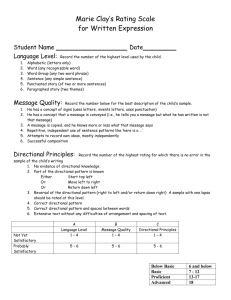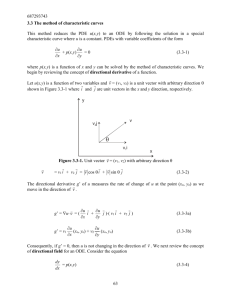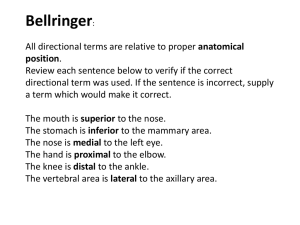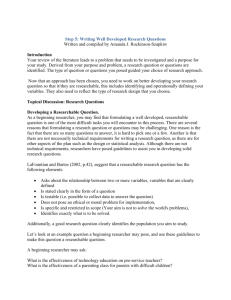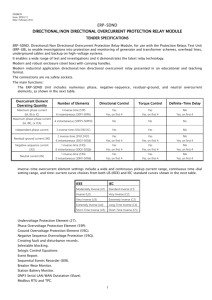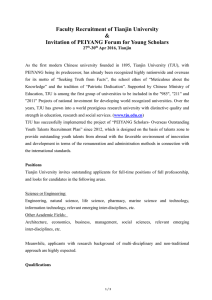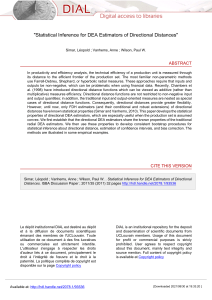View Extended Abstract - United States Association for Energy
advertisement
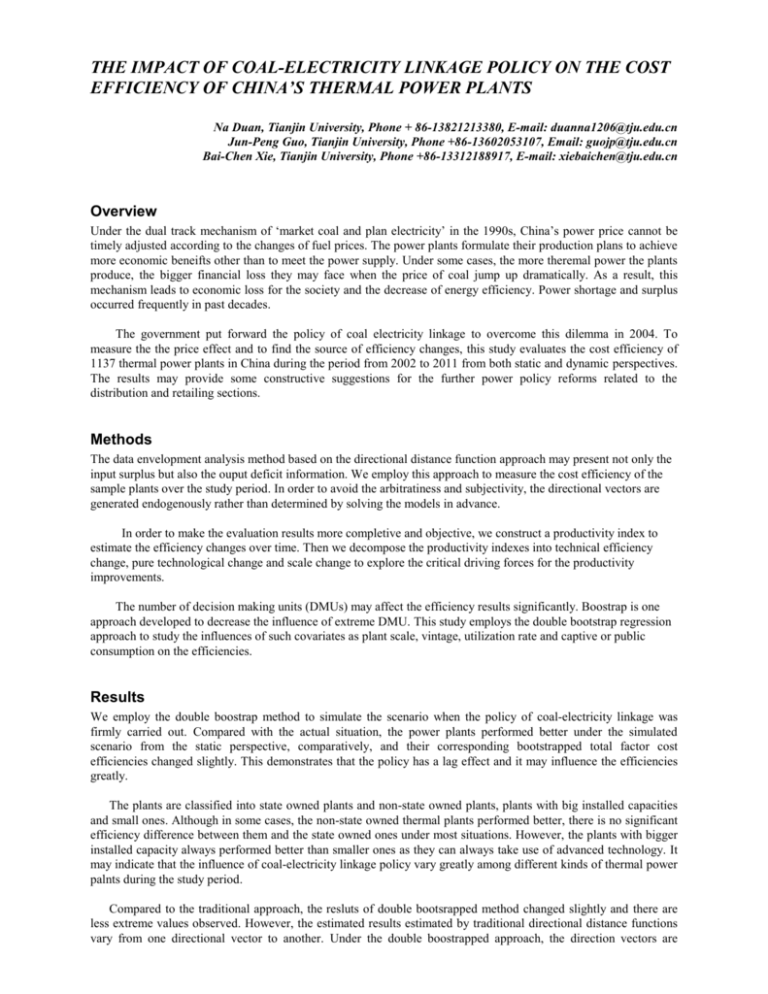
THE IMPACT OF COAL-ELECTRICITY LINKAGE POLICY ON THE COST EFFICIENCY OF CHINA’S THERMAL POWER PLANTS Na Duan, Tianjin University, Phone + 86-13821213380, E-mail: duanna1206@tju.edu.cn Jun-Peng Guo, Tianjin University, Phone +86-13602053107, Email: guojp@tju.edu.cn Bai-Chen Xie, Tianjin University, Phone +86-13312188917, E-mail: xiebaichen@tju.edu.cn Overview Under the dual track mechanism of ‘market coal and plan electricity’ in the 1990s, China’s power price cannot be timely adjusted according to the changes of fuel prices. The power plants formulate their production plans to achieve more economic beneifts other than to meet the power supply. Under some cases, the more theremal power the plants produce, the bigger financial loss they may face when the price of coal jump up dramatically. As a result, this mechanism leads to economic loss for the society and the decrease of energy efficiency. Power shortage and surplus occurred frequently in past decades. The government put forward the policy of coal electricity linkage to overcome this dilemma in 2004. To measure the the price effect and to find the source of efficiency changes, this study evaluates the cost efficiency of 1137 thermal power plants in China during the period from 2002 to 2011 from both static and dynamic perspectives. The results may provide some constructive suggestions for the further power policy reforms related to the distribution and retailing sections. Methods The data envelopment analysis method based on the directional distance function approach may present not only the input surplus but also the ouput deficit information. We employ this approach to measure the cost efficiency of the sample plants over the study period. In order to avoid the arbitratiness and subjectivity, the directional vectors are generated endogenously rather than determined by solving the models in advance. In order to make the evaluation results more completive and objective, we construct a productivity index to estimate the efficiency changes over time. Then we decompose the productivity indexes into technical efficiency change, pure technological change and scale change to explore the critical driving forces for the productivity improvements. The number of decision making units (DMUs) may affect the efficiency results significantly. Boostrap is one approach developed to decrease the influence of extreme DMU. This study employs the double bootstrap regression approach to study the influences of such covariates as plant scale, vintage, utilization rate and captive or public consumption on the efficiencies. Results We employ the double boostrap method to simulate the scenario when the policy of coal-electricity linkage was firmly carried out. Compared with the actual situation, the power plants performed better under the simulated scenario from the static perspective, comparatively, and their corresponding bootstrapped total factor cost efficiencies changed slightly. This demonstrates that the policy has a lag effect and it may influence the efficiencies greatly. The plants are classified into state owned plants and non-state owned plants, plants with big installed capacities and small ones. Although in some cases, the non-state owned thermal plants performed better, there is no significant efficiency difference between them and the state owned ones under most situations. However, the plants with bigger installed capacity always performed better than smaller ones as they can always take use of advanced technology. It may indicate that the influence of coal-electricity linkage policy vary greatly among different kinds of thermal power palnts during the study period. Compared to the traditional approach, the resluts of double bootsrapped method changed slightly and there are less extreme values observed. However, the estimated results estimated by traditional directional distance functions vary from one directional vector to another. Under the double boostrapped approach, the direction vectors are generated endogenously, which may avoid the infulence of decision makers. Comparatively, the traditional approach may lead to subjective results, under which the directional distance function is predetermined, and we have no way to get rid of the influence of the extreme inputs and outputs. Conclusions The bootstrap procedure is indispensable because the original results may only be the artifacts of sampling noise. To some extent, the boostrap approach enrichs the application of the DEA method and its extended models as the results are less dependent on the sample units. Compared to the predetermined directional vector approach and the traditonal boostrap method, the proposed double bootstrapped endogenous optimal vector method makes the estimated productivity efficiency perform better in objectivity, feasibility, and differentiation. Coal-electricity linkage gained its sucess in the short term. It not only is conducive to straighten out the relationship between coal and power prices, but also helps enhance the cost efficiency of the plants. Combined with the policy of ‘promoting the big and suppressing the small’, it may further improve the management efficiencies of power plants The advanced techonolgy played an important role in pushing the production frontier upward. The plants with bigger installed capacities performed better than the smaller ones under almost the all the conditions. Therefore, to introduce new technologies and increase research and development inputs will be an effective way to improve the cost efficiency . References Simar L., Wilson P. W.. Sensitivity analysis of efficiency scores: How to bootstrap in nonparametric frontier models. Management Science. 1998; 44(1):49-61. Simar, L, Wilson, P. W.. (1999). Estimating and bootstrapping Malmquist indices. European Journal of Operational Research, 115(3): 459-471. Simar, L., Wilson, P. W.. Estimation and inference in two-stage, semi-parametric models of production processes. Journal of Econometrics, 2007; 136(1): 31-64. Zhou P., Ang B. W., Poh K. L.. A survey of data envelopment analysis in energy and environmental studies. European Journal of Operational Research. 2008;189(1):1-18. Yu, W., Jamasb T., and Pollitt M.. Willingness-to-pay for quality of service: an application to efficiency analysis of the UK electricity distribution utilities. The Energy Journal. 2009; 30(1):1-48. Simar L., Vanhems A., Wilson P.W.. Statistical inference for DEA estimators of directional distances. European Journal of Operational Research. 2012; 220(3): 853-864. Färe, R., Grosskopf, S., Whittaker, G. Directional output distance functions: endogenous directions based on exogenous normalization constraints. Journal of Productivity Analysis, 2013; 40(3): 267-269. Duan, N., Guo J.-P., Xie and B.-C.. Is there a difference between the energy and CO2 emission performance for China’s thermal power industry? A bootstrapped directional distance function approach. Applied Energy. 2015; http://dx.doi.org/10.1016/j.apenergy.2015.02.066. Lampe H. W., Hilgers D.. Trajectories of efficiency measurement: A bibliometric analysis of DEA and SFA. European Journal of Operational Research. 2015;240(1):1-21. Arocena P., Oliveros D.. The efficiency of state-owned and privatized firms: Does ownership make a difference? International Journal of Production Economics. 2012;140(2):457-465. Yang H., Pollitt M.. Incorporating both undesirable outputs and uncontrollable variables into DEA: The performance of Chinese coal-fired power plants. European Journal of Operational Research. 2009;197(3):1095-1105. Zhang N., Kong F., Choi Y., Zhou P.. The effect of size-control policy on unified energy and carbon efficiency for Chinese fossil fuel power plants. Energy Policy. 2014; 70(1):193-200. 2
